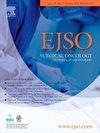一项为期12年的队列研究:食管癌圆周切除边缘(CRM)定义和定位的预后价值
IF 3.5
2区 医学
Q2 ONCOLOGY
引用次数: 0
摘要
背景:英国皇家病理学会(RCP)和美国病理学会(CAP)对食管癌围切缘(CRM)累及的定义不同。关于不同受累部位在CRM中的预后相关性的数据不足。在本研究中,我们研究了不同CRM定义和不同径向边缘位置对预后的影响。方法回顾性研究纳入2010年至2021年间449例食管癌或结直肠癌行根治性食管切除术的患者。最近的肿瘤细胞的距离,以油墨的CRM被检查和记录的位置的CRM累及。排除纵向切除缘受累的患者。从医院的电子健康记录中获得长期随访数据。结果196例(43.7%)患者在离CRM 1 mm及1 mm范围内发现肿瘤细胞(CRM- rcp R1≤1 mm)。与CRM- r0相比,CRM(≤1 mm)与较差的总生存期(OS)和无病生存期(DFS)相关,两者的p值<;0.001。61例(13.6%)患者在CRM (CRM- cap R1-0 mm)处观察到肿瘤细胞。与CRM≤1 mm患者相比,cm -0mm患者的OS和DFS较差,p值分别为0.039和0.013。肿瘤细胞(CRM≤1 mm)在CRM的多个位置的存在与单一位置相比,与较差的生存率相关;(OS p值0.008,DFS p值0.05)。后缘是最常见的单一阳性部位(44%),其次是前缘(39%)和外侧(17%)。然而,与后侧和外侧部位相比,前缘的OS和DFS较差(p值分别为0.37和0.39)。结论本研究表明,RCP定义的CRM累及是食管癌生存和复发的独立预后因素。这提高了在CRM-R1病例中追加报告CRM-0mm的价值。该研究还调查了报告CRM-R1位置的相对重要性,这可能是未来有用的预后工具。本文章由计算机程序翻译,如有差异,请以英文原文为准。
The prognostic value of circumferential resection margin (CRM) definition and location in esophageal cancer: A 12-year cohort study
Background
The definition of the circumferential resection margin (CRM) involvement for esophageal cancer varies between the Royal College of Pathologists (RCP) and College of American Pathologists (CAP). There are insufficient data regarding the prognostic relevance of different sites of involvement at the CRM. In this study, we examined the prognostic impacts of different CRM definitions and different radial margin locations.
Methods
This retrospective study included 449 patients who were treated by curative esophagectomy for esophageal or junctional cancers between 2010 and 2021. The distance of the closest tumour cells to the inked CRM was examined and site of CRM involvement was recorded. Patients with an involved longitudinal resection margin were excluded. Long-term follow up data were obtained from the hospital's electronic health records.
Results
Tumour cells at or within 1 mm from the CRM (CRM-RCP R1≤1 mm) was observed in 196 patients (43.7 %). CRM(≤1 mm) was associated with poorer overall survival (OS) and disease-free survival (DFS) compared to CRM-R0, p-values <0.001 for both. Tumour cells at the CRM (CRM-CAP R1-0 mm) was observed in 61 patients (13.6 %). Patients with CRM-0mm had poorer OS and DFS compared to CRM≤1 mm, p-values 0.039 and 0.013 respectively. Presence of tumour cells (CRM≤1 mm) at multiple locations of the CRM was related to poorer survival compared to a single location; (OS p-value 0.008, DFS p-value 0.05). The posterior margin was the most common positive single CRM-positive site (44 %), followed by anterior (39 %) and lateral sites (17 %). However, the anterior margins carried poorer OS and DFS compared to posterior and lateral sites, (p-values 0.37 and 0.39 respectively).
Conclusion
This study demonstrated that CRM involvement as defined by RCP was an independent prognostic factor for both survival and recurrence in esophageal cancer. It promoted the value of additional reporting CRM-0mm in CRM-R1 cases. The study also investigated the relative importance of reporting CRM-R1 location, which might be a useful prognostic tool in the future.
求助全文
通过发布文献求助,成功后即可免费获取论文全文。
去求助
来源期刊

Ejso
医学-外科
CiteScore
6.40
自引率
2.60%
发文量
1148
审稿时长
41 days
期刊介绍:
JSO - European Journal of Surgical Oncology ("the Journal of Cancer Surgery") is the Official Journal of the European Society of Surgical Oncology and BASO ~ the Association for Cancer Surgery.
The EJSO aims to advance surgical oncology research and practice through the publication of original research articles, review articles, editorials, debates and correspondence.
 求助内容:
求助内容: 应助结果提醒方式:
应助结果提醒方式:


